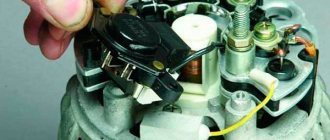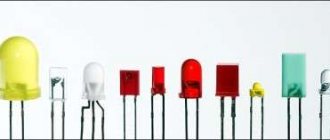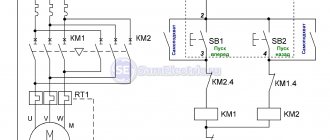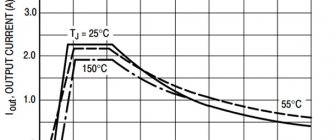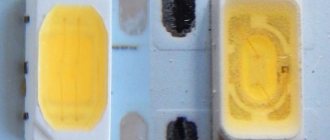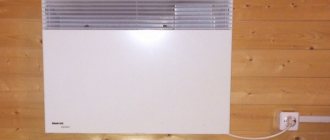TV does not respond to commands? Don’t rush to sound the alarm and save money to replace it. You may just need to repair the remote control. When the TV remote control does not work, of course you can suspect that the entire device has failed. However, usually the situation is resolved much simpler. The problem will be fixed if you simply fix the TV remote control.
Where to carry out repairs, and how difficult is it? If your TV remote control is broken, use the instructions in this article.
Types of breakdowns
You can control your TV in two ways:
- Through the buttons located on the front panel of the device;
- Via remote control.
And here there is an excellent opportunity to determine the source of the problem: if there is no response from the TV when you press the remote control buttons, but the TV executes commands when the control is from the front TV panel, then you will have to diagnose the remote control. But if the TV does not respond to either its buttons or the remote control, then, most likely, you are dealing with more serious problems in the equipment itself.
To understand how to repair the TV remote control, you need to figure out where the problem might be:
- The remote control may either not work at all - that is, when you press any button, there is no response from the TV;
- The remote control device does not work well - commands are executed, but not from all buttons or with a noticeable delay.
In the first case, the problem may be the lack of a power source or broken contacts on the chip. Incorrect operation of the remote control is most often due to discharged batteries or a case filled with liquid.
Causes of failure of the TV remote control
If the remote control does not function, then you need to find the reasons for its failure. Each person will be able to understand the problems associated with the operation of the TV program switch. You can even repair the remote control yourself. Repairing a remote switch will cost less than buying a new one.
The main reasons for the remote control failure:
- the batteries are dead;
- LED burned out;
- the graphite coating under the buttons of the rubber button pad has worn off;
- the printed circuit board is cracked and the tracks are disconnected;
- the ceramic resonator or capacitor has failed;
- solders near the resonator, capacitor, and LED have oxidized;
- the circuit board and rubber base are covered with sticky dirt;
- oxide deposits appeared on the battery contacts.
The batteries are low
80% of all calls to service workshops regarding a broken TV remote control are caused by batteries. The first thing to do when diagnosing failures of the remote control is to replace the batteries with new ones.
Even if you only installed new batteries a few days ago, you should try updating them. Batteries may be defective or expired; often, even in original packaging, these elements may be “dead.”
If you have a voltmeter in your house, you can check their voltage with this device. The minimum charge value should be 1.3 V. If the battery potential is lower, it must be replaced.
Check the operation of the remote control with new batteries; further repairs may not be required. If they are not the reason, move on to the next stage.
Content:
- 1 Features of the remote control
- 2 Common causes of breakdowns
- 3 Options for breakdowns and methods of recovery after falls 3.1 Sequence of disassembling the remote control
- 3.2 How to repair the board
The remote control is a practical addition to your TV. It makes it easy to switch channels and make settings. But over time, the buttons stop working partially or completely. And it says that it’s time to repair the TV remote control. You can do it yourself, or take it for repairs. And if the device cannot be restored at all, you can always buy an analogue or original on the electronics market.
Some buttons don't work
It happens that some buttons on the TV remote control do not work well: you have to press them with great force each time. This is also a very common problem, which can be solved by simply cleaning the device.
The remote control may be clogged with dust or small particles of household dirt. These devices are also often filled with water, coffee or juice. The sticky mucus that collects under the button prevents the contacts from touching, which is why there is a delay or complete absence of the signal.
But how can you repair buttons with such dirt on your own? It’s very simple: the device should be disassembled and cleaned.
- Remove the batteries.
- Unscrew the connecting screws on the remote control.
- Carefully separate the two parts of the housing from each other. If something is in the way, do not force it, but inspect the device again; perhaps you missed some kind of fastening connection (often a bolt can be hidden under the batteries, for example). If the case has special latches, then you need to open them using a flat screwdriver inserted into the strip connecting the two parts of the remote control.
- You should have 2 housing parts, an internal contact rubber band and a microcircuit in your hands.
Carefully and slowly inspect each element. Despite the simplicity of the device, there are many small workers in it, so it is better to carry out an inspection using a magnifying glass.
To carefully detach the two parts of the plastic housing of the remote control, you can use not only a screwdriver, which can leave small chips and scratches. For this procedure, some masters use a regular plastic card, which is issued by all chain stores.
Remote control device
All remote controls have a similar design. Main components:
- Frame. Consists of two halves, glued or twisted.
- Printed circuit board. The board contains a small microcircuit, a few more radio elements, an infrared LED, battery compartment contacts and a contact pad in the form of conductive tracks.
— Rubberized pad with buttons.
- Batteries.
Cleaning from moisture and dirt
Anything that has oily dirt can be wiped with a damp cloth or cotton wool soaked in alcohol. However, if the remote control is old, the dirt may be unexpectedly heavy. It would seem where this dirt would come from, but, as practice shows, all remote controls collect dirt.
Take a small basin and pour warm, clean water into it. Add a few drops of dish detergent and lather the solution. Place all the elements of the remote control in it, including the circuit board. Don't worry, without power there will be no short circuit. After some time, all the dirt will become wet and it will be easy to remove, for example, with a regular toothbrush.
Clean the board with radio components especially carefully: they must not be damaged. The contacts on the microcircuit and the buttons themselves on the reverse side of the rubber element must be black! After all dirt has been removed, rinse the parts with running water, pat them dry with a dry towel and place them in a warm, dry place for 30-40 minutes to dry completely.
If the button contact has a graphite coating, then the reason for poor operation may be that it is worn out and erased. Regular chocolate or cigarette packaging will help solve the problem. You just need to cut paper-based foil into squares or circles of the appropriate size and glue the pieces with the paper side to the contacts.
It is best to glue the foil to the contacts using “Moment” or silicone-based glue. There is also a special product for this type of need, but buying it specifically for 1-2 buttons is impractical. Also on the market are special repair kits for remote controls, which contain buttons with conductive coating and a small tube of adhesive.
When should you buy a new remote control?
There are situations when repairing the remote control yourself is impossible. For example, you need to re-solder a board, but you don’t have the skills to work with a soldering iron. Or a suitable element was not found in the nearest radio equipment stores.
In these situations there are two options:
- Take the remote control to the nearest TV repair shop. They will order the necessary elements and quickly carry out repairs. But the cost can be quite high.
- Buy an analogue on the radio engineering market. Or order delivery of the original device.
Buying an analogue is much cheaper. There, on the electronics market, you can immediately buy a multifunctional remote control, which will help if the remote control from the set-top box fails or replace three devices at the same time.
The main thing is to choose “not empty-handed.” It is best to take an old remote control to the store that is broken and cannot be repaired. So, it’s faster and easier to find an analogue or original specifically for your TV model.
Found a mistake? Select it and press ctrl+enter
- 60
Cracks after a fall
Remote controls can be located in a variety of places, as they should always be at hand: after waking up, you look for the remote control on the bedside table, when you have breakfast, the device lies with you on the table, and during an evening movie show, the remote control moves to the sofa next to you.
They are compact and comfortable, but they fall quite often, and this does not always happen on soft carpet. If the remote control is dropped on ceramic tiles, it can suffer serious damage not only to the outer case, but also to the internal microcircuits.
If after a fall the remote control ceases to function, then its restoration also begins with disassembly. There are three common damage caused by impact:
- Broken LED;
- The battery terminal is broken;
- The quartz resonator is damaged.
The first two faults can be determined by visual inspection. The operation of the LED can be checked without even disassembling the housing:
- Turn on the camera on your smartphone.
- Point the remote control at the camera so that the LED is in focus.
- Look at the mobile phone screen and press any button on the remote control. The signal, if any, will be clearly visible through the camera.
You can also check the operation of the LED using a multimeter, but to do this, the outer parts of the housing will have to be removed:
- Connect the tester probes to both ends of the LED.
- Set the device switch to 3V.
- Press any button on the remote control.
- If the tester shows voltage, then the LED is working.
After an unsuccessful fall of the remote control, the contact terminal of the batteries may be damaged. The spring contacts of this connection are soldered to the chip, so make sure that the soldering is not broken and is firmly in place. Also check the springs themselves for corrosion or bending. If the contacts are oxidized, you can clean them with sandpaper.
If you find ring cracks or oxidation in the soldering of the contact terminals and decide to solder them again, then the correct thing to do is to disconnect all the elements from the board, clean and tin them, and only then solder them again.
But checking the performance of a quartz resonator is not so easy. To do this, you need to disassemble the remote control and find on its microcircuit a small box with soldered contacts. If you gently shake it and hear the sound of crumbs rolling inside, then the resonator is broken and will need to be replaced. Only a master can revive such a bullet.
If the TV remote control was dropped on the floor and immediately after that you noticed that the device stopped working, then when disassembling the remote control you should pay attention to the ceramic resonator.
TV does not respond to remote control commands
If neither cleaning nor replacing batteries helps, the remote control is visually intact, but the TV does not respond to its commands, you should check the condition of the electronic part. To do this, the remote control is disassembled. When troubleshooting, you need to act carefully and carefully.
Lost contacts
When remotes are dropped or simply over time, a variety of devastating consequences can occur. After disassembling the remote control, inspect:
- area of the LED, the state of its legs;
- wires from the battery compartment, their condition, strength of soldering to the main board;
- condition of other parts with legs.
If breaks or broken conductors are found, repairs with a soldering iron or complete replacement of parts with damaged contacts are necessary.
Advice! It would not be superfluous to inspect the back surface of the electronic board. In places where the ends of the component legs have sunk deep, it is worth adding tin and working with a soldering iron.
Troubleshooting
During the initial visual inspection, most simple problems are detected and eliminated. If this does not help restore the operation of the remote control, it is worth checking the condition of some electronic components of the board. They start with an LED. Batteries are inserted into the power compartment. You will need a smartphone to check. The camera starts on it. The remote is pointed at her lens. If the LED is working properly, when you press the buttons, the smartphone, whose camera also captures waves invisible to the eye, will clearly display flashes. If the element is broken, the user will not see anything.
The second difficult problem is the failure of the quartz resonator necessary to generate a signal for the TV. Some manufacturers place this element in different parts of the electronic board. Therefore, you will have to determine the breakdown by ear. The board is gently shaken near the ear: if a rustling sound is heard, as if from rolling grains of sand, it means that the resonator is damaged and requires replacement . You can do this yourself or take the remote control to a workshop.
How can I solve the problem?
After diagnosing the equipment, you need to choose a solution to the problem that corresponds to the specific problem:
- change batteries if they are dead;
- check the operation of the LED in case of signal failure;
- Check the internal components for damage due to the remote control being dropped.
To understand which repair method to choose in a particular situation, it is best to carefully study each of them.
Most problems that arise with the remote control can be solved yourself!
Change batteries
To change the batteries on the remote control, follow these steps:
- Open the protective cover of the power system elements, which is most often located at the bottom of the rear side of the case.
- Remove old batteries.
- Insert new batteries. Pay attention to the power poles. The minus must be combined with the minuses, and the plus with the plus.
- Carefully close the protective cover.
After completing all steps, you can continue to use the device.
Batteries run out extremely suddenly for users, so it’s a good idea to keep a few, or even a pack, at home in case the ones in the device run out.
Check LED
The LED is the most important part of any remote control. It is this small light bulb that transmits the infrared signal with the desired command to the TV. Without it, the bullet is simply useless.
The LED should first be inspected for physical damage. The light bulb should not have scratches or dents, and even more so, it should not be broken.
The user must then check the LED's functionality. This can be done using any smartphone camera. By pointing the device at the device and switching channels, you can notice how the light is on - this means that the LED is working correctly.
If problems are found in one of the two checks, then the device must be noticed. To do this, you need to buy an LED in a specialized electronics store and carefully solder the light bulb into the remote control chip.
Open and check for internal damage
In case of mechanical damage to the case, the internal parts of the device are most often also damaged. This kind of damage is the easiest to notice. There will be dents or chipped plastic in the outer shell of the remote control.
However, there are often cases when, after a fall or strong impact, the body of the remote control has no visible mechanical damage, but despite this, the internal system of the remote control is damaged and because of this the device ceases to function fully.
Closed damage is also indicated by the sound of knocking on plastic walls, as if something was loose inside.
To check for physical damage, you need to open the case. Some remote controls are equipped with screws, so to open their “shell” you just need to unscrew the fasteners with a small Phillips screwdriver.
Other models are fastened with latches; such devices are opened using a knife with a thin blade. It must be carefully inserted into the gap between the halves of the case and slowly disconnected from each other.
When opening the case with a knife, you must be extremely careful not to damage the microcircuits.
Video instruction that demonstrates how to open the remote control yourself and check it for internal damage
If individual buttons do not work
There are many reasons why the remote control buttons do not work:
- Wear of the graphite layer.
- Liquid has entered the device.
- Mechanical damage to the device.
It is important to understand that malfunction of the buttons is a consequence of the breakdown, and not its cause. Therefore, in order to begin any repair actions, you should find out why this or that key fails.
Video instructions with different ways to solve problems with erased buttons
If there is an oily liquid inside
Often, when you press the buttons on the remote control, you can see a dark oily liquid. The first thing that comes to every user’s mind is that some kind of liquid was spilled on the device. However, this fluid is collected from fat that is secreted by the pores of the fingers.
It is extremely easy to clean the remote control from this oily liquid. To do this, you need to disassemble the case and thoroughly wipe the entire internal system.
How to restore lost contacts
Broken contacts of microcircuits can only be restored using a soldering iron. You should use this device with extreme caution so as not to further damage the remote control.
How to restore the graphite layer on the board
The graphite layer is located at the lower level of the buttons and is in contact with the microcircuits. Over time, this layer wears off and the buttons stop functioning. However, this problem is easy to solve on your own. To do this, you need to buy a special kit with glue and additional graphite heels at a radio electronics store and repair the remote control yourself.
Many repairmen replace the store-bought graphite layer with ordinary food foil.
Obvious problems
The vast majority of complaints about the remote not working well are due to its power supply being drained . Most often these are ordinary salt batteries. They need to be replaced before looking for more serious problems. This is done as follows:
- The remote control is turned over for inspection;
- in its lower part or in the center there is a battery compartment cover (it can be attached with a latch or fixed with a screw);
- The cover is removed by unscrewing the screw or pressing the latch area and moving the part in the direction indicated by the arrow.
After the batteries are removed, the contact pads should be inspected. On one side of the compartment there is a plate with protrusions, on the other there are two springs. There should be no oxides on these parts; if any are detected, cleaning is carried out. It is convenient to use a thin metal screwdriver and alcohol.
Important! If the contact pads are excessively worn or oxidized, the remote control can only be revived by replacing them. Service workshops will definitely have the necessary spare parts.
If everything is in order with the metal parts, you need to insert the batteries into the compartment and check the operation of the remote control. The TV may not respond. In this case, continue to press the buttons. If the batteries heat up during the test, it means that there are short circuits or other malfunctions in the TV remote control in the electronic circuit of the remote control. The easiest way out is to take the device to a service center. You can try to restore its operation yourself using one of the methods described below.
The second common cause of breakdowns is falls and impacts. If the remote control stops working after this, there may be serious damage to the electronics. It is better to replace a device with a split casing, since repairs at the service center will cost more than a new remote control. As well as efforts to resuscitate the remote control unit on our own.
Add a link to a discussion of the article on the forum
RadioKot >Schemes >Digital devices >Household appliances >
| Article tags: | Remote control remote controlAdd tag |
Universal teaching remote control
Author: GoldenAndy Published 09/01/2021 Created using KotoEd.
When there are more remote controls than hands or how not to become Shiva the Many-Arms
(picture from the Internet)
What the remote control can do.
A learning remote control is a remote control that can remember an IR message from another remote control and then try to reproduce it. But since there are many remote control command formats in the world, the task becomes non-trivial. Especially for the ATMEGA8 microcontroller.
But I hope that I have solved this problem at least partially.
Brief characteristics: ATMEGA8A controller 30 buttons Power supply 3-5 volts Battery voltage indication, parcel control (2 LEDs - red and green) Consumption in standby mode ~2 µA (at 3 volts)
The remote recognizes several common formats and attempts to emulate them according to specifications. Unknown formats are also analyzed and tried to be reproduced.
Recognized formats with emulation according to specifications:
- SONY (SIRC-12, -15, -20 bit), 40 kHz
- NEC, 38 kHz
- SAMSUNG, 38 kHz
- SHARP, 38 kHz
- JVC, 38 kHz
- RC5 (Philips), 36 kHz
Typical formats, emulated with a 38 kHz carrier:
- Format with constant pauses, encoding is carried out by pulse length, a separate start pulse is possible (like SONY). Up to 64 bits of data.
- Format with constant pulses, coding is carried out by the length of the pause, a separate start pulse and start pause are possible (as with NEC). Up to 64 bits of data.
- Format with constant pulses, encoding with different pause lengths (like SHARP). Up to 64 bits of data.
Unrecognized formats are emulated with a 38 kHz carrier.
- The remote control also tries to record such formats of messages, analyzing the lengths of pulses and pauses in order to reproduce them later. Depending on the complexity of the format, the remote control can store up to 16 or up to 32 pulses. More information about such preservation will be given below.
Initially, the remote control was made in a 12-button version, in the housing of a car remote control on the steering wheel. But then the scheme “matured” to 30 buttons.
The option for repetition is a 21-button Chinese remote control “IR remote control HX1838 for Arduino” or a maxi version - a 30-button remote control with clock buttons - a board measuring 115 * 40 mm.
History of development.
It so happened that I got the car in the “homeless” configuration. Those. there was minimal audio preparation, but there was no radio. Prology DVS-1140 was chosen as the head unit .
The main reasons for choosing are the picture from the rear view camera and support for flash drives and SD.
This “combine” came with a remote control. It's like a waffle with 40 buttons.
The remote control is not ergonomic at all. It's almost impossible to use by touch. Which automatically makes it impossible to use the remote control while moving. And I bought a universal learning remote control on Ali with a steering wheel mount. Here it is. The issue price is about $4.
10 buttons (volume control buttons on the back) + learning button.
Excellent training and very comfortable. About a year. Then it began to glitch, and then stopped working altogether. A fresh battery didn't help. The remote control seemed to be learning, when sending a command it sent something (it was visible on the phone’s camera), but no device responded to this message. And the remote control was put on the shelf for a long time. But the thought of restoring the remote control remained.
And now we got around to breathing new life into the remote control.
The first stage of development involved making a new board for the car remote control and writing the basic functionality for the remote control to work in the car. And in a short time, so that you have time to get a working remote control before going on vacation. The remote control worked, the trip was a success, about 3800 km were driven. The remote control successfully drove the entire trip and showed its best side.
The second stage of development is to teach the remote control to learn various commands of various remote control formats and use the acquired knowledge.
| Somewhere I have already seen the process of switching the processor into learning mode. Feel like Sarah Connor |
| “And the consoles will rise from the ashes of nuclear fire, and the war will begin to control the TVs!” |
Universal learning remote control.
Analysis of protocols.
IR control protocols vary. But most protocols boil down to the fact that the remote control sends data, encrypting it with the duration of IR pulses and/or pauses between pulses. Also, the information parcel may be preceded by a starting impulse of individual duration. In addition, in the vast majority of modern protocols, a pulse does not imply a constant glow of an infrared LED, but modulation of the carrier frequency by these pulses. And for different protocols this frequency is also different. For example, for RC5 it is 36 kHz, for NEC, Samsung - 38 kHz, Sony uses 40 kHz... There are other, more exotic formats with a carrier frequency of up to 56 kHz. Modulation allows the receiver to more clearly distinguish the message from the remote control from external light and interference. In addition, this allows, while maintaining average power, to increase the current through the emitting diode, which helps to increase the range.
This design uses 38 kHz as the base carrier frequency for unknown protocols. However, for known formats, the carrier frequency is set according to the format. To train the remote control, a receiver with a frequency of 38 kHz (type TSOP1838, HX1838, VS1838, HX1838, VS1838) is used. It accepts both 36 and 40 kHz satisfactorily...
There are quite a lot of different formats. For example, RC5. The so-called bi-phase, Manchester coding. Easy to recognize, easy to decode.
Or a format with a fixed pause between pulses (Sony). Here the starting pulse and then pulses of various lengths with fixed pauses are clearly monitored.
A format with a fixed pulse and different pauses (NEC, JVC, Samsung, etc.)... Here, too, there is a start pulse, a start pause, then there are pulses, and the information is encoded by pauses between pulses.
Format with information encoding by pause lengths (Sharp). It can be seen that the message has three durations - pause 1, pause 2 and impulse.
Another coding option. Some nameless fan remote control. Information is encoded by pulse length with a fixed pulse repetition period.
The above graphs (by the way, real ones, taken by a logic analyzer) show that the different durations of pulses, pauses, start pulse and start pause differ quite greatly from each other in duration. At least 2 times. Often, all these durations are also multiples of the shortest one. This allows, by recording the signal in the form of pulse durations and pause durations in a buffer array, to analyze and group these durations. A tolerance of ±25% is in most cases sufficient to distinguish one duration from another. Well, in any case, I didn’t have any problems with receiving the parcel correctly. The resulting durations are added to an array. Durations in the buffer array are assigned indices, after which you can already work with the index array. It is lighter and, in the case of the 8-bit ATMEGA8, even faster.
Moreover, if this is an unknown format, then for this format it is possible to save an array of ordered durations and indexes of pulse and pause durations for the entire message.
From the above graphs it can be seen that the number of ordered durations is from two to four. Four is good. Because it is encoded in two bits. An unknown protocol with two durations is generally encoded with one bit per send/pause duration, with three or four - two bits.
The remote control has 30 buttons. EEPROM in ATMEGA8 - 512 bytes. Of these, 10 bytes are occupied by service information. If the remaining information is divided into 30 buttons, you get 16 bytes of data per button.
These 16 bytes are divided like this:
The type of saved package is 1 byte. Number of information pulses - 1 byte Array of measured durations - 4 bytes Clock period - 1 byte Pause duration between sendings - 1 byte.
There are 8 bytes left for writing data. Or 64 bits.
For recognized formats, this allows 64 bits of data to be stored.
Simple mathematics shows that for unrecognized formats, when the durations of both bursts and pauses are stored, with 2-bit encoding we can store a maximum of 32 duration indexes. In reality, this will be a maximum of 31 indexes - 16 impulses and 15 pauses. With 1-bit encoding (when there are only two durations) we can store up to 63 duration indexes. (32 pulses, 31 pauses).
In principle, I believe that for most equipment such as televisions, media players, cable/satellite decoders, etc. - It's enough.
Scheme.
Clicking on the diagram will open it larger. And for those who don't need it, here's the diagram in PDF.
The buttons are connected to the controller by a 2 x 15 matrix. The applied controller can exit the most energy-saving mode only by applying a low level to the INT0 or INT1 input. INT1 is occupied by the photodetector. That leaves INT0. Accordingly, the first wire, the column of the button matrix, is connected to the INT0 input, and the second is connected to it through a diode. Unfortunately, such a connection will not allow recognizing the simultaneous pressing of buttons on the same line (SW1 and SW16, for example). The first 15 buttons will have priority. But for remote control this is not critical.
Button SW1 is special. Pressing it for a long time (more than 2.5 seconds) enters the remote control into learning mode. Accordingly, for this button, auto-repeat of commands when holding the button is disabled. The remaining 29 buttons are absolutely equivalent from the program's point of view. And if you wire the board yourself, you can place them as you like, in any order and configuration. There are also no requirements for the placement of the SW1 button, but for the convenience of using the special function, it is advisable to place this button somewhere on the edge of the keyboard field. For example, in two versions of the board I placed this button in the upper left position. When training the remote control, you can assign a command to this button that does not require a long press and hold of the button. For example, on/off, input selection, play/pause, etc.
If you are planning a stripped-down version of the remote control with fewer buttons, you can remove any buttons except SW1 (otherwise you will not be able to put the remote control into learning mode).
A photodetector is connected to the INT1 interrupt input. To reduce current consumption, the power of the photodetector is turned on only when teaching the remote control.
The controller's power supply is additionally decoupled by a diode and capacitors C2, C3, so that power supply interference during command transmission does not affect the operation of the controller so much. SS14 is used as a decoupling diode - a fairly powerful (40 V, 1 A) Schottky diode. Oddly enough, at low currents it has a lower voltage drop than the originally planned small BAT46.
Printed circuit board.
2 versions of the printed circuit board have been developed.
Option number one. "Spherical remote control in a vacuum." This is just a board, without fitting into any case. Size 115 x 40 mm, 30 tact buttons. The wiring is one-sided, with a relatively small number of jumpers.
Gerberas.
Option number two. The board layout is made for a Chinese remote control.
Hint: If you buy a set from the Chinese - a remote control plus a receiver - then you don’t have to look for a photoreceiver separately. If you're lucky, the receiver board also has a red LED of size 0805.
Features of the board. The native Chinese board is about 0.9 mm thick. Accordingly, your board must also be made on thin (0.8 - 1.0 mm) PCB. Since the top side of the board is also a plane for gluing the front film with rubber bands, there should be no protruding elements on this side.
Adapters should ideally be soldered with a very, very thin wire (hair from mgtf, for example) with a minimum amount of solder. Only keyboard polling signals pass through the transitions; there are no power circuits there. Tin the contact pads with a minimum amount of solder and then, perhaps, walk over them with a stream of air from a soldering hair dryer so that all the nodules/lumps are removed.
Information LEDs of standard size 0805 are soldered on the back side of the board, upside down, with the crystal in the hole. So that the diode lens does not protrude above the front of the board. Then they will shine through the sticker, but will not lift it.
Photodetector. The Chinese receiver is too thick, almost 5.5 mm. And the space between the board and the bottom surface of the case is 4 mm. Accordingly, in order not to look for expensive flat receivers (and Vishay has such), a hole is drilled in the lower plane of the case for the receiver lens. You can drill with a 2 mm drill, and then select a thicker chamfer from the inside. You can also peel off the metal screen of the receiver. At least 0.5 mm will also be gained.
Gerberas.
Fuses and firmware.
Fuses:
For those who are closer to the numbers, here they are: High 0xD1 Low 0xE4
Firmware.
To flash the firmware, you need to solder the wiring from the programmer to the corresponding contact pads - Ground (GND), MO(MOSI), MI(MISO), SCK, Reset. Connect +5 volts from the programmer to the “+” contact of the battery compartment. The battery must be removed. If the programmer supports logical levels of 3.3 volts when flashing, the “+” from the programmer can not be connected to the remote control, but flashed with the battery inserted.
On the version of the board for a small Chinese remote control, I also added a separate patch + power supply, so that it would be easier to supply power from the programmer.
In principle, the firmware has been debugged and tested. But if any errors are suddenly discovered or additions are made, I will post the updated firmware here and on my blog.
Brief instructions for learning the remote control and its use.
Power supply to the remote control. Data about saved commands is stored in the EEPROM of the controller. A checksum is used to verify data integrity. When power is applied, the remote control turns on the green control diode and checks the data stored in the EEPROM. If the data is valid, after about 0.2 seconds the LED will go out and the remote control will go into energy saving mode. If there is no data or it is invalid, the red LED will light up and the remote control will format the EEPROM to the required information storage structure. After a little more than a second, the LED will go out and the remote control will go into energy saving mode.
Remote control mode. In normal mode, pressing a remote control button sends a command recorded on that button.
In this case, while the command is being sent, the green control LED lights up or, if the battery voltage is below 2.7 volts, the red LED lights up. All buttons except the first one, when held, send a command repeat as long as the button is pressed. When you press the SW1 “Set” button, the remote control will send a command and one repetition, then the time will be counted to enter the training mode. If there is no written command on the button, the control LED lights up briefly and no data is sent.
Training mode. A long press (more than 2.5 seconds) of the SW1 “Set” button puts the remote control into learning mode. When you press and hold the button, the red LED lights up after 2.5 seconds. When the button is released, the red and green LEDs begin to flash. In this mode, the remote control turns on the photodetector and waits for a message from the external remote control.
Within 6 seconds, you must point the external remote control at the photodetector and press the required button. If the remote control correctly recognizes the command, the green LED will begin to blink rapidly and you must press the button on the remote control within 6 seconds to which you want to record the received command. The green LED lights up and stays on for a little over a second. Data about the received command is stored in EEPROM. If you do not press any button within 6 seconds, the remote control will return to standby mode. After saving the command, the remote control will return to learning mode and will wait for the next command from the external remote control. If the remote control does not recognize the command, the red LED lights up for about a second, signaling an error, after which the remote control will return to learning mode and will wait for the next command from the external remote control. If no command is received by the remote control within 6 seconds, the remote control will go into standby mode.
Deleting saved commands. To delete a command stored on a button from a button, you must put the remote control into learning mode. In learning mode (red and green diodes flash), you must press the button from which you want to delete the saved command. The red diode will begin to flash rapidly and within 2 seconds you need to press the SW1 “Set” button to confirm the deletion of the command. If a saved command is successfully deleted, the green LED will light up for a little over a second and the command will be erased from non-volatile memory. If you do not press anything during these two seconds or press any other button (not SW1), the deletion will not occur, the remote control will return to learning mode.
Files:
Gerbera remote control for 21 buttons Firmware Gerbera remote control for 30 buttons Diagram in PDF
All questions in the Forum.
| What do you think of this article? | Did this device work for you? | |
| 47 | 2 | 2 |
| 0 | 0 |
 Thudum-tum-thudum!
Thudum-tum-thudum!
